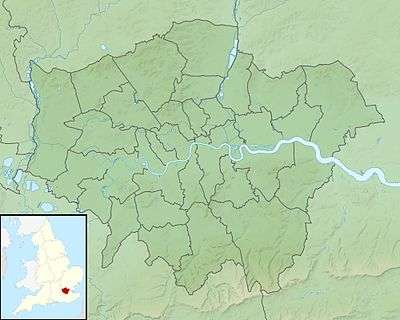UK Holocaust Memorial
| Location |
London, United Kingdom |
|---|---|
| Coordinates | 51°29′45″N 0°07′29″W / 51.49586°N 0.12481°WCoordinates: 51°29′45″N 0°07′29″W / 51.49586°N 0.12481°W |
| Type |
Memorial |
| Architect |
David Adjaye |
 Location of UK Holocaust Memorial  UK Holocaust Memorial (Greater London)  UK Holocaust Memorial (the United Kingdom) | |
The UK Holocaust Memorial is a planned memorial to the victims of the Holocaust that is intended to be built in the southern part of Victoria Tower Gardens in London, United Kingdom, close to the Houses of Parliament. The memorial is intended to honour the Jewish victims of the Holocaust and all other victims of Nazi persecution, including Roma, LGBT, and disabled people.[1]
Background
The memorial design was decided on through an international competition that had 92 entries, leading to 10 finalists that were decided on by a panel of 13 people comprising Peter Bazalgette (chair), Charlotte Cohen, Samantha Cohen, Daniel Finkelstein, Alice Greenwald, Ben Helfgott, Sajid Javid, Natasha Kaplinsky, Sadiq Khan, Ephraim Mirvis, Julia Peyton-Jones, Sarah Weir and Paul Williams.[1]
In October 2017, it was announced that it will be designed by the British architect David Adjaye (through Adjaye Associates), built by Ron Arad Architects and landscaped by Gustafson Porter + Bowman.[1]
The British government has allocated £50 million to the UK Holocaust Memorial Foundation (UKHMF) to support the construction of the memorial, which is now at an early design stage. Additional funding is being sought for the construction of the learning centre.[1]
The memorial would supplement, in London, the Hyde Park Holocaust Memorial, opened in 1983, the permanent Holocaust exhibition of the Imperial War Museum and the Wiener Library for the Study of the Holocaust and Genocide.
Location
In January 2015, David Cameron announced on behalf of the Holocaust Memorial Foundation that there was to be a new UK Holocaust Memorial and associated Learning Centre built in central London. At that stage three particular sites were proposed: the Imperial War Museum (IWM), near London City Hall, and the Millbank Tower podium. The Imperial War Museum was embarking on a renewal of its existing Holocaust galleries and saw an excellent opportunity to achieve all the goals of the Holocaust Commission, not least the education of this and future generations. The IWM commissioned a design from the architects Foster + Partners, which included a memorial garden, underground contemplation space and wall of remembrance, with the option of an underground extension to the existing Learning Centre.[2]
However, the UKHMF wished to mount an architectural competition and regarded the IWM, less than one mile from the Houses of Parliament, as not being in Central London, so the IWM offer was turned down. Instead they undertook a search over fifty locations and in July 2016 it was announced that Victoria Tower Gardens, the smallest of London's Royal Parks, had been chosen for both the memorial and underground learning centre.[3]
Victoria Tower Gardens is a public park along the north bank of the River Thames in London. It is adjacent to the Victoria Tower, the south-western corner of the Palace of Westminster and extends southwards from the Palace to Lambeth Bridge, sandwiched between Millbank and the river. Victoria Tower Gardens is a Grade II* listed park created in 1864–70 following the embankment of the Thames. It is in a Conservation Area, is partly within the UNESCO World Heritage Site of Westminster, and is designated a zone of Monument Saturation.[4]
The park is already home to three memorials that raise awareness of injustice, namely The Burghers of Calais, the Buxton Memorial Fountain and the Emmeline and Christabel Pankhurst Memorial. Architect David Adjaye intends his construction to be contextualised among these other memorials,[1][5] but campaigners who oppose the destruction of parkland have objected that the Holocaust memorial is vastly different, in scale and nature, to the existing memorials.[6]
The park is also home to a small children's playground and often plays host to temporary cultural events including the light installation spectra, by Japanese artist Ryoji Ikeda, which commemorated the centenary of the start of the First World War, and outdoor film screenings. It is cherished by many as a surprisingly peaceful green space in the heart of London.[7]
The proposed construction will be submitted for planning permission to Westminster City Council who will have to bear in mind their own rules on new monuments in this zone, the effect on heritage views of the Palace of Westminster and the Mayor of London's stated commitment to protect London's green spaces from development.[8]
Design
The memorial combines a sculpture with an underground learning centre[9] that will help to educate visitors about prejudice and discrimination. The sculpture consists of 23 bronze fins, with the gaps between the fins representing the 22 countries where the Holocaust destroyed Jewish communities, and acting as separate paths down to a hall named the 'Threshold' containing the learning centre, along with a "contemplation court" and "hall of testimonies".[1]
See also
References
- 1 2 3 4 5 6 "Adjaye Associates and Ron Arad Architects win UK Holocaust Memorial international design competition". UK Government website. Retrieved 24 October 2017.
- ↑ "AJ uncovers Foster's unbuilt Holocaust Memorial designs for Imperial War Museum". Architects' Journal. October 2017.
- ↑ "Bazalgette: Holocaust Memorial Should Make a Powerful Statement". Architects' Journal. September 2016.
- ↑ City of Westminster. "Statues and monuments in Westminster. Guidance for the erection of new monuments supplementary planning document" (PDF).
- ↑ Jonathan Morrison (24 October 2017). "London Holocaust memorial design for Victoria Tower Gardens unveiled". The Times. Retrieved 24 October 2017.
- ↑ Moore, Rowan (February 2017). "The Guardian". The Guardian.
- ↑ "Hansard: Holocaust Memorial Museum debate". February 2017.
- ↑ Mayor of London (August 2017). Greener City Fund Prospectus. London: Greater London Authority. pp. Foreword.
- ↑ "Winning Design For London's Holocaust Memorial Revealed". Londonist. 24 October 2017.